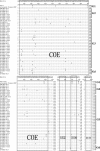Two Distinct Genotypes of Porcine Epidemic Diarrhoea Virus in Vaccinated Pig Flocks in Shandong Province of China, 2012-2015
- PMID: 28188693
- PMCID: PMC7169864
- DOI: 10.1111/tbed.12546
Two Distinct Genotypes of Porcine Epidemic Diarrhoea Virus in Vaccinated Pig Flocks in Shandong Province of China, 2012-2015
Abstract
As one of the top pork producers in China, Shandong Province suffered frequent outbreaks of porcine epidemic diarrhoea virus (PEDV) on pig farms from January 2012 to July 2015, resulting in significant economic losses. To better understand the prevalence situation, we conducted molecular epidemiological analyses of 38 PEDV strains isolated from 13 cities in Shandong Province. The detection rate of PEDV was 71.2% (146/205) by reverse transcription polymerase chain reaction (RT-PCR). The S genes of the 38 isolated samples were 4146 to 4161 nt in length and shared high levels of sequence identity (93.3-99.6% nt, 92.1-99.4% aa) with those of the 41 reference strains. Among the 38 strains, 31 strains that occupied 12 cities were classed into G3 genotype, while the other seven that only existed in four cities were classed into G2 genotype. In addition, the strains CH-SDLY-2-2014 and CH-SDLY-3-2014 isolated from Linyi were classed into the Gd subgenotype. Notably, there were multiple insertions or deletions in the S genes and several mutations in the neutralizing epitopes of the PEDV S protein. Overall, the results revealed that G2 and G3 are the predominant PEDV genotypes circulating in Shandong Province during 2012-2015, and Gd subgenotype in G3 group had already spread towards northern China in 2014.
Keywords: Gd subgenotype; S gene; genotype; mutation; porcine epidemic diarrhoea virus.
© 2017 Blackwell Verlag GmbH.
Conflict of interest statement
The authors declare no conflict of interests.
Figures



References
-
- Burland, T. G. , 2000: DNASTAR's Lasergene sequence analysis software. Methods Mol. Biol. 132, 71–91. - PubMed
-
- Chang, S. H. , Bae J. L., Kang T. J., Kim J., Chung G. H., Lim C. W., Laude H., Yang M. S., and Jang Y. S., 2002: Identification of the epitope region capable of inducing neutralizing antibodies against the porcine epidemic diarrhea virus. Mol. Cells 14, 295–299. - PubMed
MeSH terms
Associated data
- Actions
- Actions
- Actions
- Actions
- Actions
- Actions
- Actions
- Actions
- Actions
- Actions
- Actions
- Actions
- Actions
- Actions
- Actions
- Actions
- Actions
- Actions
- Actions
- Actions
- Actions
- Actions
- Actions
- Actions
- Actions
- Actions
- Actions
- Actions
- Actions
- Actions
- Actions
- Actions
- Actions
- Actions
- Actions
- Actions
- Actions
- Actions
- Actions
- Actions
- Actions
- Actions
- Actions
- Actions
- Actions
- Actions
- Actions
- Actions
- Actions
- Actions
- Actions
- Actions
- Actions
- Actions
- Actions
- Actions
- Actions
- Actions
- Actions
- Actions
- Actions
- Actions
- Actions
- Actions
- Actions
- Actions
- Actions
- Actions
- Actions
- Actions
- Actions
- Actions
- Actions
- Actions
- Actions
- Actions
- Actions
- Actions
- Actions
LinkOut - more resources
Full Text Sources
Other Literature Sources
Research Materials

